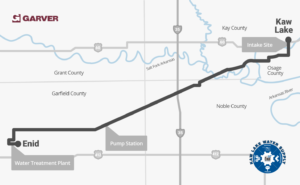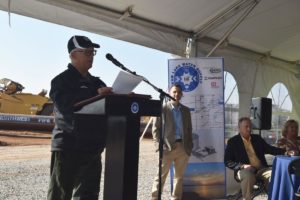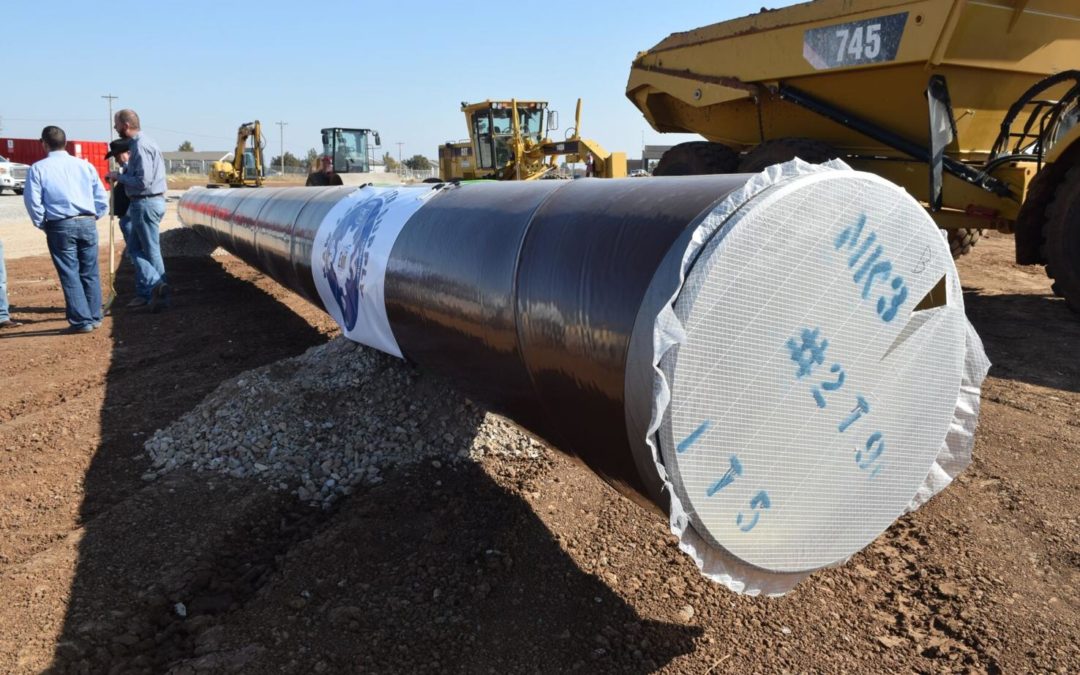ENID, Okla. — With ceremonial shovels in hand, city officials and project engineers struck gold Tuesday as they broke ground on the site of Enid’s future wastewater treatment plant.
Construction on the treatment plant buildings, to be located on 40 acres on West Chestnut near Enid city limits, will continue for the next two years, project engineers said following a groundbreaking ceremony on the mostly empty site Tuesday morning.
The treatment plant is intended as a final component of the major Kaw Lake water pipeline project, which is elsewhere beginning construction after years of planning and roadblocks.
Garney Construction, the engineering company managing the project build, is pushing for substantial completion date of the entire Kaw Lake Water Supply project by the back half of 2023.
Jason Jansen, Garney construction project manager, said construction already has begun on the pipeline’s horizontal direction drills, and bore-tunnel subcontractors could mobilize as early as the first part of next week.
About 70 miles of 30- and 36-inch pipeline will transport millions of gallons of raw water from an intake structure at Kaw Lake, a reservoir sitting between Osage and Kay counties. The water will travel uphill through four major crossings and through a booster pump station near Garber, which will continue pushing the water through to Enid. 
At the Chestnut treatment plant, water then will be gathered, treated and turned from raw water supply into potable drinking water, Jansen said.
Finally, a 2-mile-long distribution pipeline along Chestnut will move the water into the city’s existing water system, bringing an average 10.5 million gallons of water a day to Enid residents for at least the next half-century.
Construction of the intake site’s 100-foot vertical shaft structure will continue through the end of the year, Jansen said, before work begins on a micro-tunnel that’ll extend laterally into the lake.
Jansen said Garney is looking to advertise subcontractor bids for the Chestnut water main during the first quarter of 2022. City staff are currently in the midst of acquiring a total 25 parcels of land needed to construct the water main across private properties.
Enid’s mayor said Tuesday he sees the ongoing project as a “community dream” — one five years in the making to prevent a major loss of water supply. Even in 2009, the city of Enid had access to 6 million gallons of water per day, but droughts in the early-2010s brought water to the front of conversation.
 “Community leaders need to solve the immediate issues of the day, and we’re always putting out fires, right? But more importantly, they need to have then vision and fortitude to address the issues that have an impact well into the future,” Mayor George Pankonin said ahead of the ground-breaking ceremony. “This water pipeline is a perfect example of that forward-thinking.”
“Community leaders need to solve the immediate issues of the day, and we’re always putting out fires, right? But more importantly, they need to have then vision and fortitude to address the issues that have an impact well into the future,” Mayor George Pankonin said ahead of the ground-breaking ceremony. “This water pipeline is a perfect example of that forward-thinking.”
City engineering director Chris Gdanski said the day was a celebration of the patience of his colleagues at Garney and Garver, as well as a celebration of the forethought of the people of Enid.
Despite some doubts before the start of the project back in 2014, Gdanski said, “You can’t imagine how excited I am that this day is here.”
Assistant City Manager Scott Morris said Enid’s leadership had the initial vision to undertake the city’s largest project in history.
“I’ve always heard it said that it takes a village to raise a child, and a project of this size, it surely does take a village,” Morris said.
The Kaw Lake project, budgeted at roughly $313 million, is Enid’s most expensive capital construction project, so local and state leaders together made several efforts to minimize costs on interest loans and other regulatory fees.
Several loans totaling $330 million from Oklahoma Water Resources Board will cover much of the initial financing, in partnership with the state Department of Environmental Quality and the U.S. Environmental Protection Agency.
One of these four loans — providing $205 million from the Oklahoma Drinking Water State Revolving Fund program — was OWRB’s largest-ever loan, to be paid back over 30 years with a 1.84% interest rate using city tax revenue.
These funding sources will save Enid residents over $26.4 million in financing and interest charges, OWRB chair Julie Cunningham said Tuesday.
Under a new provision in the 2020 version of a federal water resources bill, the city of Enid also will now pay the U.S. Army Corps of Engineers $8 million less than expected in storage fees to access the water in the Arkansas River Basin the latter oversees.
Though Oklahoma U.S. Sen. Jim Inhofe was unable to attend Tuesday’s ceremony in-person, his state director, Brycen Panas, said this provision in 2020’s U.S. Water Resources Development Act came to be known as the “Enid provision.”
Panas said his boss had in 2018 managed to convince USACE’s then-commanding general to testify before the Senate’s Environmental and Public Works Committee that the Corps’ development regulations were outdated.
Now, as part of the WRDA, with any new contracts at a hydropower lake within the basin — such as Kaw Lake — entered into before Dec. 31, 2022, a local government entity will not pay more than 110% of the initial principal cost for the acre-feet being sought for the new covered contract for that lake.
In January, the Tulsa District of the USACE’s Southwestern division issued a Finding of No Significant Impact in compliance with the National Environmental Policy Act.
Some 20 million people total are served water in the Oklahoma-centric region of the USACE’s Southwestern division, U.S. Army Col. Scott Preston said Tuesday.
Preston, commander of the Tulsa district, said 75% of the USACE’s nationwide water supply is in the division with 60% of that supply in the Tulsa district.
Article & photos by: Alexander Ewald Enid News & Eagle 11.10.21

